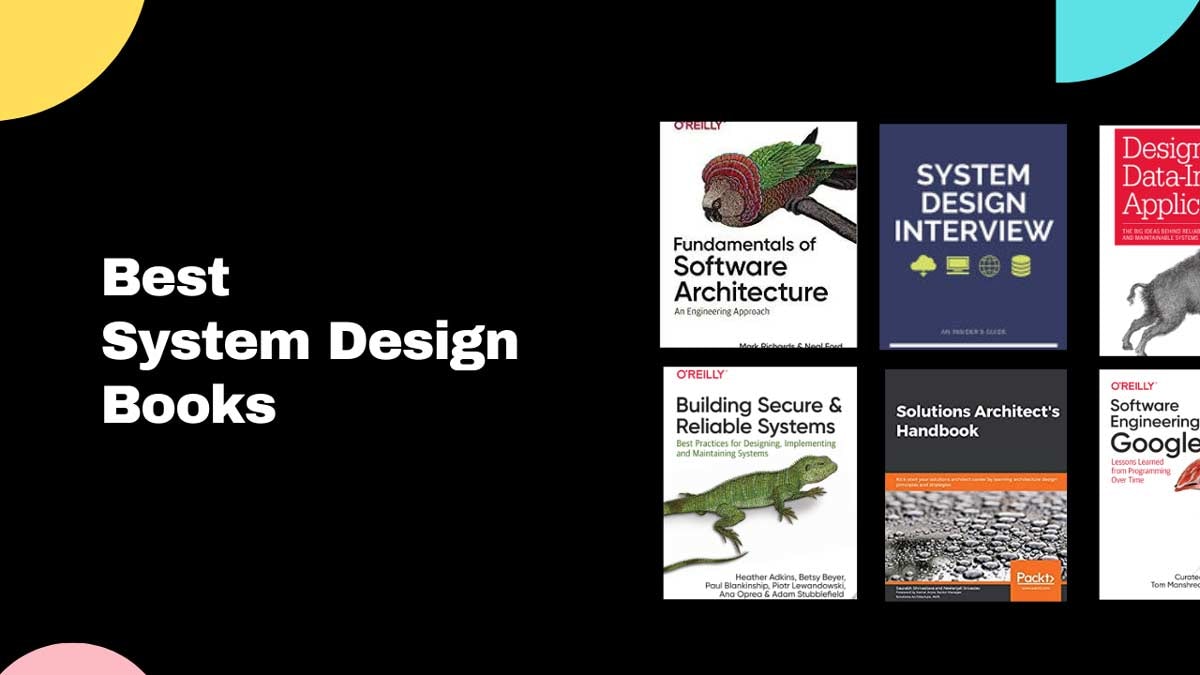8 Best System Design Books in 2023
Most popular
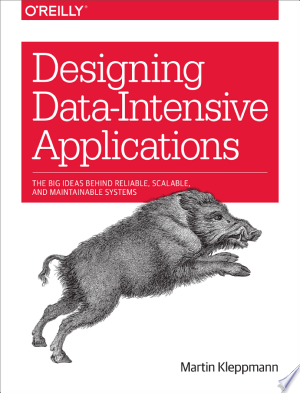
- The basics of system design
- Understand how to apply system design concepts in practice
- Understand different technologies for processing and storing data
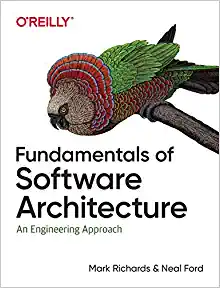
- Understand the basics of system design
- Learn about different architecture patterns
- Understand how to identify and work with components
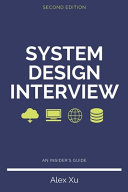
- Understand what system design interviewers are looking for.
- Learn how to systematically solve system design questions.
- Gain exposure to 16 real system design interview questions with detailed solutions.
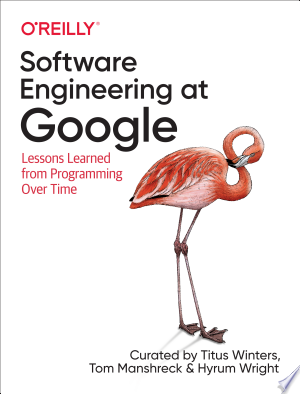
- Understand system design
- Learn how to write resilient code over time
- Understand the impact of scale on software engineering practices
If you're looking for a comprehensive guide to system design, look no further.
With these system design books, you'll learn how to create systems that are optimized for efficiency, reliability, and performance.
Whether you're new to system design, preparing for a job interview, or working on an advanced project, there's a book here that will help you take your skills to the next level.
Best system design books:
1. Designing Data-Intensive Applications: The Big Ideas Behind Reliable, Scalable, and Maintainable Systems

Designing Data-Intensive Applications is a comprehensive guide to designing the systems that collect, process, and store data.
Author Martin Kleppmann helps you understand the trade-offs around consistency, scalability, fault tolerance, and complexity so you can make informed decisions when choosing technologies for your application.
You'll also learn from case studies of major online services like Google, Facebook, and Twitter. With this book, software engineers and architects will have the knowledge they need to design data-intensive applications that are both efficient and reliable.
If you're looking for the ultimate guide to system design, look no further than Designing Data-Intensive Applications. This comprehensive resource offers in-depth insights into everything from big data processing and NoSQL databases to system fault tolerance, scalability, and efficiency. With expert author Martin Kleppmann as your guide, you'll get a deep understanding of the many tradeoffs involved in building modern data applications, and learn how to make informed decisions when selecting the right tools for your needs.
Authors: Martin Kleppmann
Topics covered
You will learn how to:
- The basics of system design
- Understand how to apply system design concepts in practice
- Understand different technologies for processing and storing data
- Gain an understanding of the trade-offs around consistency, scalability, fault tolerance, and complexity when designing system architectures
- Explore the architectural principles behind modern online services, such as Amazon and Facebook, and learn how to apply them in your own projects.
2. Fundamentals of Software Architecture : An Engineering Approach

Fundamentals of Software Architecture is a comprehensive overview of software architecture's many aspects. You'll go through architectural characteristics, architectural patterns, component determination, diagramming and presenting architecture, evolutionary architecture, and many other topics.
Mark Richards and Neal Ford are hands-on practitioners who have taught software architecture classes professionally for years. In this book they focus on architecture principles that apply across all technology stacks.
You'll explore software architecture in a modern light, taking into account for all the innovations of the past decade.
This book examines topics such as architecture patterns, components, soft skills, modernity, architecture as an engineering, and many more.
If you're an aspiring or experienced software architect looking for a comprehensive guide to the field, look no further than Fundamentals of Software Architecture. Written by leading experts in the field, this book offers in-depth coverage of all aspects of system design, including architectural
Authors: Mark Richards, Neal Ford
Get the bookTopics covered
You will learn how to:
- Understand the basics of system design
- Learn about different architecture patterns
- Understand how to identify and work with components
- Understand how to diagram and present software architecture
- Learn about modernity in system design
- Gain an understanding of the engineering discipline of software architecture
3. System Design Interview - An Insider's Guide
Best Book for System Design Interview Preparation

If you're looking to land a system design job, then you need the System Design Interview - An Insider's Guide. This book will teach you everything you need to know about system design interviews, including how to solve complex system design questions.
With 16 real system design interview questions and solutions, this book provides all the help you need to ace your interview.
Authors: Alex Xu
Topics covered
You will learn how to:
- Understand what system design interviewers are looking for.
- Learn how to systematically solve system design questions.
- Gain exposure to 16 real system design interview questions with detailed solutions.
- Understand 188 diagrams that explain how different systems work.
4. Software Engineering at Google: Lessons Learned from Programming Over Time

Software Engineering at Google provides an inside look at how Google engineers build software. It covers the company's unique engineering culture, processes, and tools, and how they contribute to the effectiveness of an engineering organization.
You'll learn three fundamental principles that software organizations should keep in mind when designing, architecting, writing, and maintaining code. These include the importance of time, scale, and trade-offs for engineers.
Written by leading Google engineers, it emphasizes the importance of managing a living codebase that can adapt and evolve. With practical advice and real-world examples, it will help you understand how system design impacts software engineering practices at scale and how to navigate the complex trade-offs inherent in system design decisions.
Authors: Titus Winters, Tom Manshreck, Hyrum Wright
Topics covered
You will learn how to:
- Understand system design
- Learn how to write resilient code over time
- Understand the impact of scale on software engineering practices
- Explore the trade-offs in system design decisions
5. Solutions Architect's Handbook : Kick-start your solutions architect career by learning architecture design principles and strategies
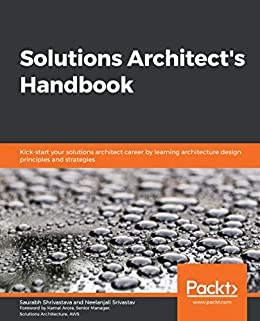
The Solutions Architect's Handbook helps you understand essential concepts, design principles and patterns, architectural considerations, and the latest technology you need to know to become a successful solutions architect. With this book, you'll learn how to create an efficient architecture that meets your business requirements.
Whether you're working on cutting-edge software projects or modernizing legacy applications, this guide will help you become a successful solutions architect. You'll explore system design fundamentals, design patterns, and security considerations, as well as how to work with big data, machine learning, and the Internet of Things. With practical guidance on documentation and soft skills, you'll develop all the skills needed to take your career to the next level.
So if you're ready to dive into today's fast-changing software landscape, don't wait - get started with The Solutions Architect's Handbook today!
Authors: Saurabh Shrivastava, Neelanjali Srivastav
Get the bookTopics covered
You will learn how to:
- Understand system design principles
- Learn different system design patterns
- Gain experience in modernizing legacy applications
- Understand big data processing, machine learning, and IoT architectures
- Learn how to document architecture designs and develop your soft skills as a solutions architect
6. Building Secure and Reliable Systems: Best Practices for Designing, Implementing, and Maintaining Systems
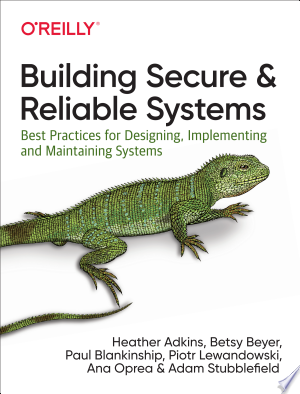
Building Secure and Reliable Systems provides insights from practitioners who specialize in security and reliability, teaching you how to design scalable and reliable systems that are fundamentally secure.
The book covers system design, implementation, and maintenance from a security and reliability standpoint, offering recommendations for coding, testing, and debugging practices.
You'll learn about secure and reliable systems through case studies and best practices that will help your organization adopt these methods successfully. Whether you're working in system design, testing, or operations, this book is essential reading for anyone who wants to create reliable and secure software systems.
Authors: Heather Adkins, Betsy Beyer, Paul Blankinship, Piotr Lewandowski, Ana Oprea, Adam Stubblefield
Topics covered
You will learn how to:
- Understand system design principles
- Learn how to implement secure and reliable systems
- Gain insights into system maintenance best practices
- Explore strategies for building a culture that supports system design and reliability
7. Building Event-Driven Microservices
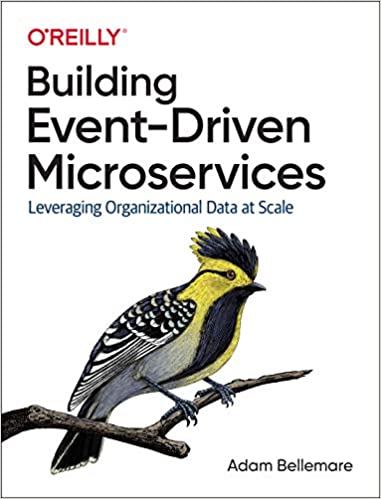
Building Event-Driven Microservices will teach you how to build event-driven microservices that are powered by large-scale data usage. Author Adam Bellemare takes you through the process of creating an event-driven microservice-powered organization. You'll reconsider how data is produced, accessed, and propagated across your organization. Additionally, you'll learn powerful patterns for unlocking the value of data as well as how to incorporate event-driven design and architectural principles into your own systems.
If you're looking to design systems that can handle large amounts of data, then this practical guide is just what you need.
Authors: Adam Bellemare
Topics covered
You will learn how to:
- Learn how to leverage large-scale data usage across the business units in your organization
- Understand the role of microservices in supporting event-driven designs
- Discover architectural patterns to ensure success within and between teams in your organization
- Gain knowledge about application patterns for developing powerful event-driven microservices
- Get a grasp of the components and tooling required to get your microservice ecosystem off the ground, and much more!
8. Architecting for Scale: How to Maintain High Availability and Manage Risk in the Cloud
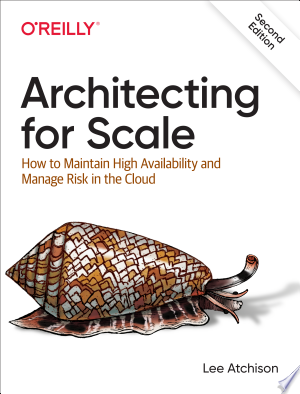
Architecting for Scale is a comprehensive guide that gives you techniques you need to build systems that can handle huge quantities of traffic, data, and demand.
You'll learn how to architect your system for scale and improve availability without affecting quality. The book also explores a modern service-based application architecture that ensures high availability and reduces the effects of service failures. Whether you're an architect, manager, or director in engineering or operations organization, this guide will help you build applications that are scalable, reliable, and respond to the needs of your customers.
Authors: Lee Atchison
Topics covered
You will learn how to:
- Learn about system design
- Understand how to build applications that can handle huge quantities of traffic, data, and demand
- Know how to architect applications for high availability
- Discover ways to mitigate risk in systems and reduce the impact of system failures
- Explore best practices for leveraging the cloud to build highly scalable applications that meet customer needs.
Conclusion: System Design Books
- Designing Data-Intensive Applications is a guide to designing reliable, scalable, and maintainable systems.
- Fundamentals of Software Architecture provides an overview of software architecture's many aspects.
- System Design Interview - An Insider's Guide teaches you everything you need to know about system design interviews.
- Software Engineering at Google provides an inside look at how Google engineers build software.
- Solutions Architect's Handbook helps you understand essential concepts, design principles and patterns, architectural considerations, and the latest technology needed to become a successful solutions architect.
- Building Secure and Reliable Systems covers system design, implementation, and maintenance from a security and reliability standpoint with recommendations for coding practices.
- Building Event-Driven Microservices covers how to design systems that can handle large amounts of data using event-driven microservices.
- Architecting for Scale explores how to maintain high availability and manage risk in the cloud by architecting scalable applications.
Josip Miskovic is a software developer at Americaneagle.com. Josip has 10+ years in experience in developing web applications, mobile apps, and games.
Read more posts →Last modified on:
- 1. Designing Data-Intensive Applications: The Big Ideas Behind Reliable, Scalable, and Maintainable Systems
- 2. Fundamentals of Software Architecture : An Engineering Approach
- 3. System Design Interview - An Insider's Guide
- 4. Software Engineering at Google: Lessons Learned from Programming Over Time
- 5. Solutions Architect's Handbook : Kick-start your solutions architect career by learning architecture design principles and strategies
- 6. Building Secure and Reliable Systems: Best Practices for Designing, Implementing, and Maintaining Systems
- 7. Building Event-Driven Microservices
- 8. Architecting for Scale: How to Maintain High Availability and Manage Risk in the Cloud
- Conclusion: System Design Books

I've used these principles to increase my earnings by 63% in two years. So can you.
Dive into my 7 actionable steps to elevate your career.
Related Posts
- Best Web Development Books
- Best Software Testing Books
- Best Git Books
- Best SQL Books
- Best React Books
- Best GraphQL Books
- Best C# Books
- Best Python Books
- Best Terraform Books
- Best Node.js Books
- Best Rust Books
- Best REST API Books
- Best Unit Testing Books
- Best TypeScript Books
- Best Cryptography Books
- Best Kubernetes Books
- Best Next.js Books
- Best Kotlin Books
- Best Ethical Hacking Books
- Best Cloud Computing Books
